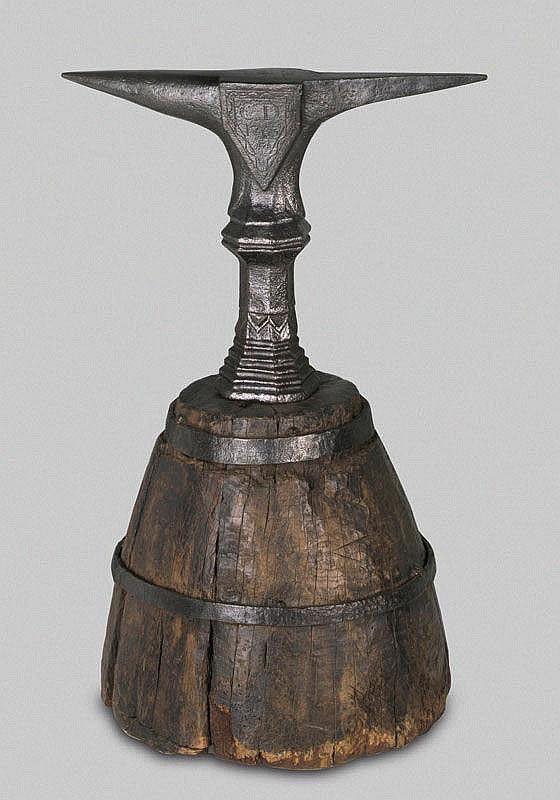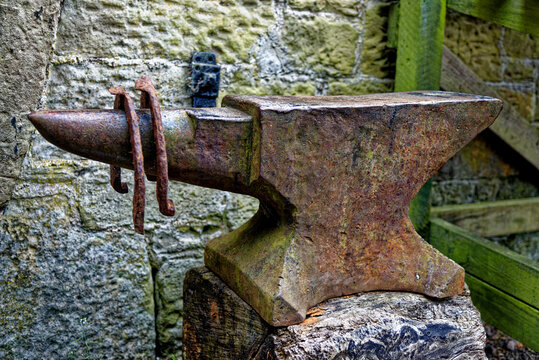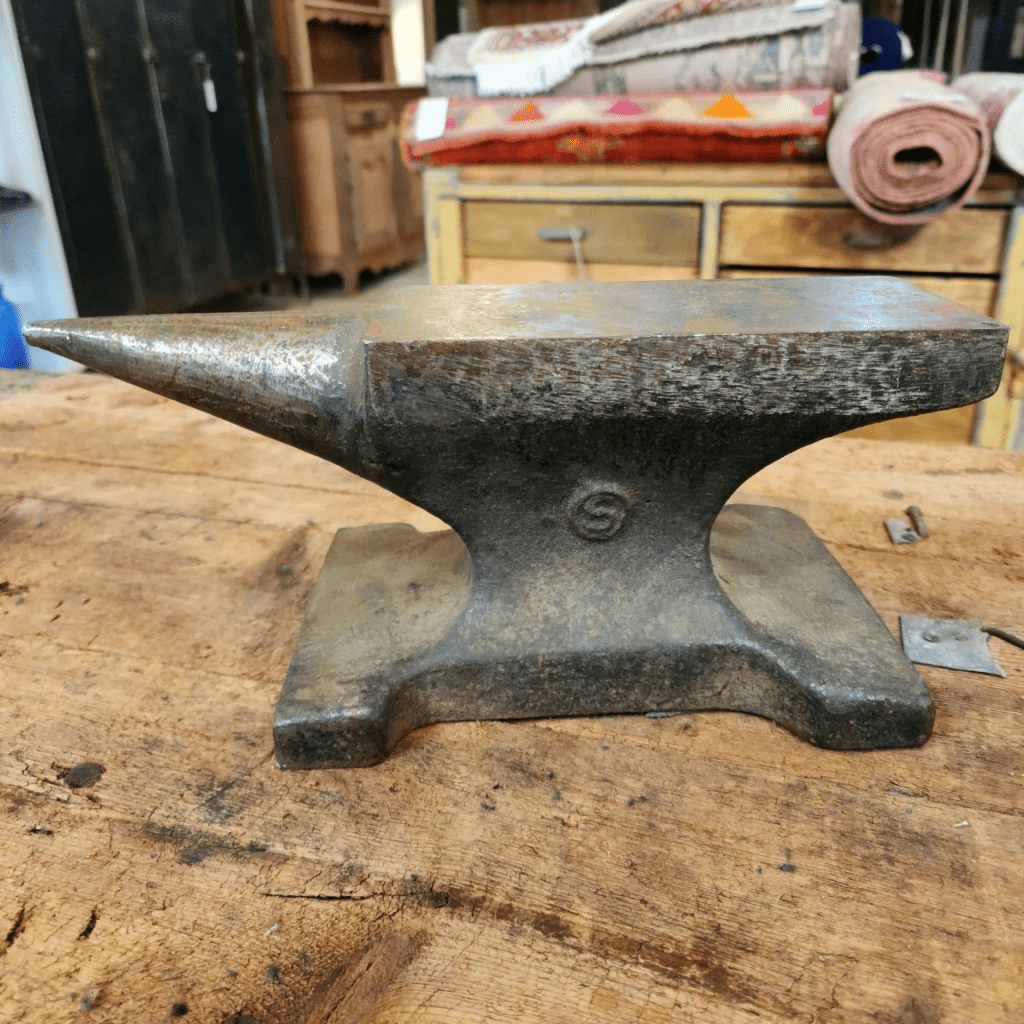What You Found: An Antique Blacksmith’s Anvil
Tucked among those dusty crates is a treasure from the age of hand-forged iron: an old blacksmith’s anvil mounted on a heavy wooden base. It isn’t just “heavy, quiet, and full of secrets”—it’s a working monument to craft. The tapered, horned top and narrow waist suggest a European double-horn style from the late 18th to 19th century, set into a stout stump to absorb hammer blows. In other words, you’re holding the platform on which nails, hinges, hooks, tools, horseshoe parts, and everyday hardware were born.

How to Identify the Features
Look closely and you’ll spot the clues that tell its story:
- Face: The flat working surface where hot iron was shaped. The smoother and flatter it remains, the more desirable it is to smiths and collectors.
- Horns: The pointed ends (yours appears to have a long conical horn and a shorter beak) used for bending and curving metal. Double-horn anvils—more common on the Continent—gave smiths flexibility for both general forging and delicate radius work.
- Waist and Foot: That elegant hourglass waist above the base isn’t just pretty; it keeps weight down while maintaining strength.
- Base/Stump: The bound hardwood base acts like a shock absorber, deadening bounce and stabilizing the anvil. The iron hoops around the wood help prevent splitting under repeated impact.
Even if you don’t see the hardy or pritchel holes common on English “London pattern” anvils, the form still tells you this was a serious, professional tool.
Where and When It Was Used
This type of anvil was common in blacksmith shops across Europe during the 1700s and 1800s. Imagine it anchored beside a coal forge, the room warm and alive with orange light. A smith heated bar stock until it glowed, then moved to this very surface to draw it out thinner, upset it thicker, or bend it into precise shapes. On a day’s work this anvil might have seen wagon fittings in the morning, kitchen hardware at noon, and a repair for a plow by dusk. It’s easy to picture calloused hands, leather aprons, and the constant rhythm of hammer on steel echoing through a small town.
Video : Blacksmithings most iconic tool, the ANVIL
What It Was Built to Do
Think of an anvil as the blacksmith’s “workbench,” but engineered for heat and force. The horn formed curves; the face refined flats; the edges created clean transitions. With tongs in one hand and a hammer in the other, the smith used the anvil to:
- Bend and scroll metal for gates, latches, and decorative ironwork.
- Straighten or true axles, blades, and bars.
- Forge-weld pieces together by heating and hammering until they fused.
- Upset and draw: compressing metal to make it thicker in one spot or stretching it thinner in another.
Every dent and ring mark on your piece is a footprint left by those processes—evidence of a lifetime spent turning raw iron into useful things.
Is It Valuable? Collectibility and Demand
Old anvils have a devoted following. Value depends on:
- Condition: A flat face with minimal chipping is prized. Deep sway or severe edge damage lowers utility and price.
- Style and age: Double-horn, forged bodies with decorative waists often draw interest from European-tool collectors.
- Weight: Heavier anvils (say, 50–200 kg) are in demand for active smithing.
- Provenance and markings: Maker’s stamps or regional symbols can lift value. If you can find faint stamps on the waist or under the face, note them.

Even as décor, a historic anvil carries presence—buyers from interior designers to heritage workshops seek them out.
How to Care for and Preserve It
You don’t need to over-polish an heirloom to honor it. In fact, restraint is your ally:
- Dust and dry-brush the metal to remove loose scale.
- Avoid aggressive grinding that erases tool history. Light hand cleaning is best.
- Seal lightly with a thin coat of mineral oil or microcrystalline wax to deter rust while letting the patina show.
- Protect the stump by brushing off debris and treating with a gentle wood conditioner (no glossy coatings that trap moisture).
- Keep it dry: Basements and barns invite condensation; choose a room with stable humidity.
Should You Restore or Leave It Be?
Ask yourself what you want from this piece. If you’ll use it for gentle display or light demo forging, preserve the face and edges but skip heavy resurfacing. If a smith plans to work it hard, a professional can carefully dress the face—again, sparingly—to keep it functional without erasing history. Over-restored anvils lose character (and sometimes value); well-preserved ones tell better stories.
Using It Safely (If You Decide to Try It)
Curious about a light demo with soft, mild steel? Safety first:
- Anchor the base so the anvil can’t rock.
- Eye and ear protection are non-negotiable.
- Gloves and tongs help control hot metal safely.
- No quenching on the face; sudden cooling can stress old steel.

If you’re new, consider a class at a local smithy before striking a blow. A couple of hours with a pro will save your tool—and your arms.
Reading the Clues in the Metal
A close look becomes a detective game:
- Hammer blooms on the face hint at repeated finishing blows.
- Shiny arcs near horn roots suggest bending work.
- Subtle edge wear shows where scrolls and corners were created.
- Indentations may match specific tools (fullers, swages) once used here.
Each mark is like a fingerprint from another century, a quiet reminder that craft outlives the craftsman.
Creative Ways to Display a Historic Anvil
Give this piece the stage it deserves:
- Entryway statement: Place it on a low platform with a small card telling its origin.
- Library or studio anchor: Pair it with old tongs or a forge shovel for a mini-exhibit.
- Photo pedestal: Its flat face makes a striking stand for small artworks or books.
- Workshop inspiration: Let it live where tools live—near a bench where creation still happens.
Video : Identifying 4 Anvils With Anvils In America
How to Tell Its Story
If you plan to pass it down, write a short “provenance sheet”: where it was found, any family memories, visible marks, dimensions, and weight. Add photos from several angles. That simple document turns an interesting object into a documented heirloom.
Why This Matters More Than Décor
Yes, it looks fantastic—but the real power is what it represents. This anvil embodies an era when towns were built as much by fire and muscle as by blueprints. It’s a lesson in durability, usefulness, and beauty born from work. In an age of disposable everything, this tool is stubbornly enduring.
Conclusion: The Object That Still Speaks
You didn’t just find an old hunk of iron; you uncovered a witness to centuries of making—an anvil that steadied iron while ideas took shape. Its horns and face carry the memory of hands that forged for a living and a community that depended on them. Preserve it, celebrate it, and let it keep telling its story. Some heirlooms whisper; this one rings—clear as a hammer stroke—about skill, patience, and the quiet pride of things built to last.